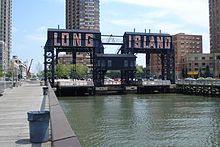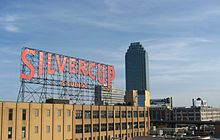Long Island City
40°44′51″N 73°56′58″W / 40.747452°N 73.949403°W

Long Island City (often abbreviated L.I.C.) is the western-most neighborhood of the borough of Queens in New York City. It is bounded on the north and west by the East River; on the east by Hazen Street, 31st Street, and New Calvary Cemetery, and on the south by Newtown Creek, which separates Queens from Greenpoint, Brooklyn. It originally was the seat of government of Newtown Township, and remains the largest neighborhood in Queens Borough. The area is part of Queens Community Board 1 north of the Queensboro Bridge and Queens Community Board 2 south of the Bridge. [1]
History


Long Island City was created in 1870 from the communities of Astoria, Hunters Point, Blissville, Ravenswood, Dutch Kills, Bowery Bay, Steinway, and Sunnyside, all in the western part of the Town of Newtown, westernmost township in Queens County. The neighborhood of Middleton was dissolved because the U.S. Post Office refused to recognize two locations with that name in the same state, and there existed a town of that name in Orange County. The heavily industrialized Long Island City was one of the three cities whose approval was necessary to create the City of Greater New York in 1898.
The term LIC is now mostly used for the south-western part of the former city (ZIP code 11101). The border with Astoria is very vague; in ZIP codes 11106, 11102 and 11105 some locals prefer the term "Astoria" (for the convenience or the status), while others (esp. long-time residents and artists) prefer to be associated with the long history of Long Island City.
Mayors of Long Island City:[2]
- Abram D. Ditmars (1870-72)
- Henry S. DeBevoise (1872-75)
- Abram D. Ditmars (1875)
- John Quinn (1876)
- Henry S. DeBevoise (1876-83)
- George Petry (1883-86)
- Patrick J. Gleason (1887-92)
- Horatio S. Sanford (1893-95)
- Patrick J. Gleason (1896-97)
Redevelopment

In recent years, Long Island City has become an increasingly popular place of residence for commuters working in Manhattan. Starting with a master plan for what is now called Queens West in the 1980s, the first building, called Citylights, was completed in 1997 along with a waterfront park shortly thereafter. Since the completion of Citylights the neighborhood began to attract a number of real estate development projects, including two projects by Avalon Bay Communities and a seven building development on the former site of a Pepsi Cola Bottling plant by Rockrose Development Corp. Since the adoption of a zoning change in 2001, a number of residential developments have sprouted around Long Island City, outside of the Queens West development.The southern portion of the Queens West, is now being developed by the city of New York and has been renamed Hunters Point South. This project will include affordable housing, a school, retail and community facilities.
Community
Long Island City surrendered its independence in 1898 to become part of the City of Greater New York. However, Long Island City is still one of the four main post offices in Queens (ZIP Code 11101 and 11109) and was formerly a Sectional center facility (SCF). It is the eastern terminus of the Queensboro Bridge, also known as the 59th Street Bridge, which is the only non-toll automotive route connecting Queens and Manhattan.

Northwest of the bridge terminus are the Queensbridge development of the New York City Housing Authority. Major thoroughfares include Vernon Boulevard, 21st Street, which is mostly industrial and commercial; Queens Boulevard, which leads westward to the bridge and eastward follows New York State Route 25 through Long Island; and the western-most portion of Northern Boulevard, which becomes Jackson Avenue (the former name of Northern Boulevard) west of Queens Plaza. The most prominent feature aside from the bridge is the community's green skyscraper, the 658-foot Citicorp Building built in 1989 on Courthouse Square, which is the tallest building on Long Island and in New York City outside Manhattan.[3]
Long Island City was once home to many factories and bakeries, some of which are finding new uses. The former Silvercup bakery is now home to Silvercup Studios, which produces notable works such as HBO's The Sopranos. The Silvercup sign is visible from the 7 Train going into and out of Queensboro Plaza. The former Sunshine Bakery is now one of the buildings housing LaGuardia Community College. Other buildings in the LaGuardia College complex originally served as the location of the Ford Instrument Company, at one time a major producer of precision machines and devices. Artist Isamu Noguchi converted a photo-engraving plant into a workshop; the site is now a museum dedicated to his work. High-rise housing is being built on a former Pepsi-Cola site, and from June 2002 to September 2004 the former Swingline Staplers plant was the temporary headquarters of the Museum of Modern Art. Other factories included Fisher Electronics and Chiclets Gum.
P.S. 1 Contemporary Art Center, an affiliate of the Museum of Modern Art, is the oldest and second-largest non-profit arts center in the United States solely devoted to contemporary art. It is named after the former public school in which it is housed.

SculptureCenter is New York City's only non-profit exhibition space dedicated to contemporary and innovative sculpture. SculptureCenter re-located from Manhattan's Upper East Side to a former trolley repair shop in Long Island City, Queens renovated by artist/designer Maya Lin in 2002. Founded by artists in 1928, SculptureCenter has undergone much evolution and growth, and continues to expand and challenge the definition of sculpture. SculptureCenter commissions new work and presents exhibits by emerging and established, national and international artists. The museum also hosts a diverse range of public programs including lectures, dialogues, and performances.
Long Island City is also home to several special high schools: Academy of American Studies (a history high school), Aviation High School, Information Technology, International High School, Frank Sinatra School of the Arts, Middle College High School, Newcomers High School, and Robert F. Wagner HS. Not to be confused with SHSAT-based high schools, these schools offer programs that are included at those schools.
Eagle Electric, now known as Cooper Wiring Devices, was one of the last major factories in the area. They have moved production to the People's Republic of China, and Plant #1, which was the largest of their factories and housed their corporate offices, is being converted to residential luxury lofts.
Long Island City is currently home to the largest fortune cookie factory in the United States, owned by Wonton Foods and producing four million fortune cookies a day. Lucky numbers included on fortunes in the company's cookies led to 110 people across the United States winning $100,000 each in a May 2005 drawing for Powerball.
Gantry Park in Hunter's Point was used as background for the final scenes of Steven Spielberg's film Munich and The Interpreter (starring Sean Penn and Nicole Kidman).
Long Island City was featured more prominently in the 1997 film, Sunday, with David Suchet and Lisa Harrow, which was filmed on location.
Long Island City is the home of 5 Pointz, a building housing artists' studios, which has been legally painted on by a number of graffiti artists and is visible near the Court House Square station on the 7 train.[4]
Long Island City is home to Water Taxi Beach, NYC's first urban beach, located within Queens West on the East River Wharf. NYC plans to build 5,000 moderate income apartments in this area.
Long Island City is also home to Online Grocery Company, FreshDirect, serving the Greater New York area via deliveries. A customer can also order online and come to the warehouse and pick up the food. Both the warehouse and administrative offices are located on Borden Avenue.
Education
Long Island City is served by the New York City Department of Education.
Long Island City is zoned to:
- P.S. 17 Henry David Thoreau School
- P.S. 70
- P.S. 76 William Hallet School
- P.S. 78
- P.S. 85 Judge Charles Vallone
- P.S. 111 Jacob Blackwell School
- P.S. 112 Dutch Kills School
- P.S. 150
- P.S. 166 Henry Gradstein School
- P.S. 171 Peter G. Van Alst School
- P.S. 199 Maurice A. Fitzgerald School
Long Island City is zoned to:
A 7-12 school called Baccalaureate School Of Global Education is in LIC.
9-12 high schools include:
- Long Island City High School
- Frank Sinatra School of the Arts
- International High School At Laguardia
- High School For Information Technology
- Middle College High School
- Aviation Career And Technical High School
- Academy of American Studies
- Newcomers High School - Academy for New Americans
- Queens Vocational High School
- Robert F. Wagner Jr. Institute For Arts & Technology
- William Cullen Bryant High School
- Information Technology High School
Trivia
This article contains a list of miscellaneous information. (December 2007) |
- Seven Major League Baseball players were born in Long Island City: Gus Sandberg (1895), Billy Zitzmann (1895), Joe Benes (1901), Tony Cuccinello (1907), Ed Boland (1908), Al Cuccinello (1914), and Billy Loes (1929).
- Two Major League Baseball players have died in Long Island City: John Hatfield (1909) and Dike Varney (1950).
- Ron Artest (NBA) is from Long Island City (Queensbrigde House Project)
- The first season of What Not to Wear (US version) was filmed in Long Island City.
- The videogame Grand Theft Auto IV, which takes place in a fictionalized version of New York City called "Liberty City", features a neighborhood called "East Island City" which resembles Long Island City in its architecture and feel. Many signs and awnings from local Long Island City businesses are used as graphical elements for stores in the East Island City area. The Silvercup sign (changed to "Silverback"), Citicorp Building and the gantry cranes in Gantry Plaza State Park, among other Long Island City landmarks, also appear in some form in the East Island City environment.
Transportation
Long Island City is served by the New York City Subway 7, E, F, G, N, W and R trains. The Long Island City Long Island Rail Road station is here, and a commuter ferry service operated by NY Water Taxi at the East River Wharf. Cars enter by way of the Queensboro Bridge, the Queens Midtown Tunnel and the Pulaski Bridge. The Roosevelt Island Bridge also connects Long Island City to Roosevelt Island. Queens Boulevard, Northern Boulevard and the Long Island Expressway all pass through the area.
References
- ^ Queens Community Boards, New York City. Accessed September 3, 2007.
- ^ The Encyclopedia of New York City, p. 690, column 3.
- ^ Citicorp Building, accessed January 6, 2007
- ^ Bayliss, Sarah (2004-08-03). "Museum With (Only) Walls". The New York Times. Retrieved 2008-03-13.
External links
- Ins & Outs Magazine
- Pictures of Astoria & LIC
- Greater Astoria Historical Society
- Long Island City Business Development Corporation
- LIC Community Boathouse
- LIC Cultural Alliance
- The Noguchi Museum
- P.S.1 Contemporary Art Center
- SculptureCenter
- Forgotten NY: Long Island City
- 1911 Britannica article
- 108th and 114th Precincts of the NYC Police, including weekly crime statistics
- Cookies contain fortunes for Powerball winners, a May 2005 article from CNN
- Cookie Master, a June 2005 article from The New Yorker
- Queensbridge Houses, NYCHA project
- New York Photography - Long Island City Photographs of Long Island City
- Water Taxi Beach

